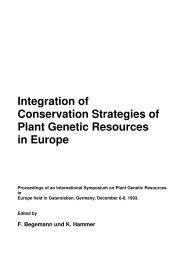Zugang zu Pflanzengenetischen Ressourcen für die ... - Genres
Zugang zu Pflanzengenetischen Ressourcen für die ... - Genres
Zugang zu Pflanzengenetischen Ressourcen für die ... - Genres
Sie wollen auch ein ePaper? Erhöhen Sie die Reichweite Ihrer Titel.
YUMPU macht aus Druck-PDFs automatisch weboptimierte ePaper, die Google liebt.
Survey of property rights and conditions of access to genetic resources on the international level<br />
But little control has been exercised over genetic information embedded in such material, and over<br />
its exchange. Collection of genetic material by individual scientists, botanical gardens and gene<br />
banks from foreign countries used to attract little attention from government agencies. Where it<br />
did, and where approval and/or special entry visas were required, host countries generally<br />
permitted collection missions on condition that their own scientists participated and samples of<br />
collected material were provided for storage at a local facility.<br />
Intellectual property protection was then of little concern. In the field of genetics it still is a<br />
comparatively recent phenomen, which started with the introduction of plant variety protection<br />
in some industrial countries in the 1930s, and was more recently extended by allowing regular<br />
(utility) patent protection to life forms.<br />
To date, international research collaboration has worked well under the free-exchange regime. An<br />
example of successful international research cooperation has been the development of highyielding<br />
wheat and rice varieties by CIMMYT and IRRI 4 in the 1960s. The Green Revolution<br />
brought together the best brains in plant breeding technology and knowledge to accomplish,<br />
without a single patent or plant breeders' right, one of the great technological breakthroughs of<br />
modern days. No less important, its breeders were able to draw on germplasm resources from all<br />
parts of the world, allowing their systematic utilization 5 .<br />
Because the use of plant genetic resources was central to their crop improvement programs, the<br />
international research centers grouped in the Consultative Group on International Agricultural<br />
Research (CGIAR) 6 have always subscribed to a policy of free exchange of germplasm 7 .<br />
Germplasm from their global collections of genetic material of the major food crops is freely<br />
available to scientists anywhere in the world, public or private, who can use it without restrictions<br />
for research or commercially. This has been the rule in their relations with partner institutions in<br />
both developing countries where the Centers collaborate with the national research systems,<br />
chiefly in the public sector, through which they disseminate their research products, and in<br />
industrial countries where they draw on advanced laboratories in industry and universities for<br />
inputs into their research programs.<br />
4<br />
5<br />
6<br />
7<br />
Centro International de Mejoramiento de Maiz y Trigo (Mexico), and International Rice Research Institute<br />
(Philippines).<br />
For a review of the results of the Green Revolution see Anderson et al..<br />
Established in 1971, the CGIAR is an association of countries, international and regional organizations,<br />
and private foundations dedicated to supporting a system of agricultural research centers and programs<br />
around the world. Sixteen centers eurrently belong to the Group.<br />
TAC Document AGR/TAC:IAR/88/4 „CGIAR Policy on Plant Genetic Resources", Rome, February<br />
1988.










